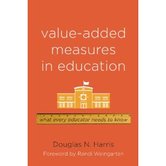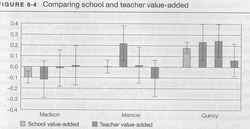
The entire book is quite well written and contains a lot of arguments either way in the use of VAM. One major thing he notes as a barrier to widespread use of the system is the fact that there are large margins of error when applying VAM to specific teachers. When New York City released the VAM scores of 18,000 teachers, the confidence intervals were 35 and 53 percent for Math and English respectively - quite a wide margin.

The other major issue to consider with this chart is that even though the teachers were different scores overall, the confidence intervals demonstrate that there was almost no true way of knowing which teacher was better than the other because of the overlap.
At the end of the book Harris makes 10 "recommendations for creating and reporting value-added measures for accountability purposes." His first recommendation is unsurprising to educators: make better tests. For years we have been noticing the decline in emphasis on critical thinking and problem-solving due to the overuse of multiple-choice questions and specific content areas (Math and English) being emphasized. He suggests that tests across the country model themselves on the International Baccalaureate (IB) exams because it is "an authentic assessment, meaning that it captures skills like inquiry and problem solving" (p. 202). He understands this will cost more money and require more time due to the increase in open-ended questions used, but recognizes that it will overall benefit our children.
This book explores the complexities of Value-Added Measurement well and is fairly balanced on the subject. I am sure there are those who would disagree with me so I hope they comment here.


 RSS Feed
RSS Feed
